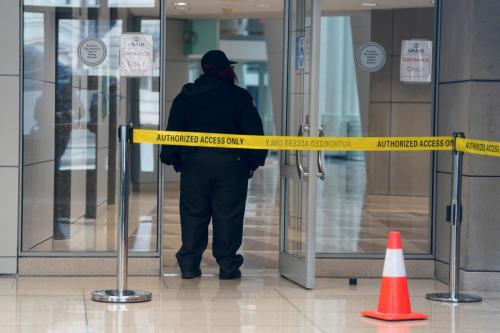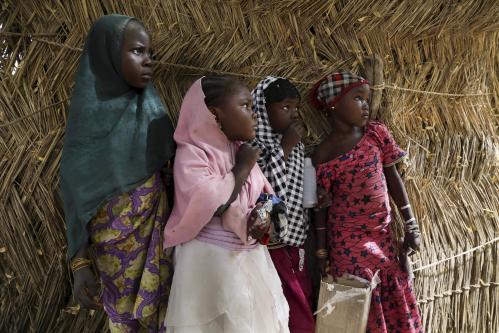Editor’s Note: The Peace Corps, although the standard of excellence for international volunteering, remains constrained by budget issues and low numbers of volunteers. Increasing the number of American’s engaged in volunteer service overseas will involve rethinking the organizational form. In a recent World View article, Lex Rieffel advises for the creation of a Corporation for International Study and Service that includes the Peace Corps and outlines key benefits.
The Peace Corps is stuck in a rut. It remains the gold standard for international volunteering but budget constraints have kept the number of volunteers in the field below 8,000. Today the Peace Corps is barely half the size it reached at its peak in the mid-1960s, despite President Bush’s request to Congress after 9/11 to rebuild to the 14,000 level.
A critical challenge for the next president of the United States will be to convince the rest of the world that we are more interested in being a reliable partner than a military superpower. The future security and prosperity of Americans will depend on the success of this effort, which can only be achieved through a mix of hard power and soft power instruments. The Peace Corps has been one of the most effective forms of American soft power since John F. Kennedy created it in 1961. Scaling up the Peace Corps to ten times its present size could be one of the smartest initiatives advanced by the next president. Based on policy analysis and deliberations carried out over the past five years, a bold move of this kind will require a new mission, a new funding model, and a new organizational form.
The new mission simply needs to reflect the immense changes in the world over the past fifty years, especially the rise of new economic powers such as Brazil, China and India. A bigger Peace Corps will only be attractive to these countries if it is more of a partnership, an exchange, a two-way street. The new funding model can be borrowed from our domestic volunteer programs. Instead of putting the full cost on American taxpayers, federal budget dollars can be combined with private sector funds: from NGOs, for-profit programs, corporations, universities, etc.
The most radical step required to have ten times as many Americans engaged in volunteer service overseas is probably the creation of a new organizational form. The task calls for an organization that will allow traditional Peace Corps service to remain the gold standard, but will accommodate a “family” of related international volunteer programs.
Four organizational forms have been considered. The one that offers the greatest advantages is a Corporation for International Study and Service that includes the Peace Corps, essentially as it is today, among half a dozen or more volunteering options.
The alternatives that appear less attractive are: keeping the Peace Corps as a federal agency but mandating it to establish several new programs with a range of service requirements; spinning off the Peace Corps into the private sector (with a basic commitment of federal funding) where it would be free to innovate both on the funding side and the program side; and enlarging the mandate of the Corporation for National and Community Service – CNCS (which administers AmeriCorps, Vista and other domestic programs) to include the Peace Corps and various new international programs.
Here are some of the benefits to expect from creating a Corporation for International Study and Service – CISS:
- Like the CNCS, the CISS would have a policy-making Board of Directors dominated by private citizens. This will make Peace Corps governance more bipartisan and more visible.
- With a fresh and broader mandate, the CISS Board would appoint as CEO a charismatic personality who could more effectively “sell” international volunteering to the Congress, to Americans seeking service opportunities overseas, and to the leading emerging market countries that will be the major drivers of global economics and politics for the next fifty years. The CEO could be the Director of the Peace Corps at the same time.
- The Peace Corps would have a better “home,” less beholden to the White House and the State Department. It will be at the heart of the CISS: recruiting, training, and supporting volunteers for two-year assignments, as it has been doing successfully for almost 50 years. It will contribute country knowledge and operational experience for the new programs to be established by the CISS. The goal of doubling the number of Peace Corps volunteers by 2011 can be more easily reached as part of a strategic approach to building bridges with the rest of the world.
- Two existing “sister” programs would also find better homes in the CISS. One is Peace Corps Response, which sends returned Corps Volunteers to “hot spots” for short-term (six month) periods of service. With co-financing, it could easily grow from 100 volunteers per year today to more than a thousand per year. The other is Volunteers for Prosperity, a “match-making” program now administered by USAID. The CISS would also be the logical home for the Global Service Fellowship Program that is now under consideration in the Congress.
- The CISS would be free to add and drop programs as the supply of volunteers and the demand from foreign countries evolves. An absolutely critical step will be to create a program to place foreign volunteers at useful sites in the United States, as science and language teachers in our public schools, for example. An obvious winner will be a new program for “Baby Boomers” that might involve shorter but repeated commitments at sites tailored to their skills and experience.
- The Peace Corps was born on a university campus. Sargent Shriver’s vision included an intense partnership with American colleges and universities. It did not materialize, but today the prospects may be better. In-service learning is booming here and in other countries. Academic leaders have been working to scale up international study. The synergies between international study and international service are clear and immense. Bringing the two together in the CISS will help both movements achieve what neither can achieve independently: more funding, greater volunteer interest, better service opportunities, and better post-study and post-service employment opportunities.
Will the next President of the United States be prepared to take a bold step of this kind? The answer depends in large part on what the candidates hear on campuses and in communities across the country this fall. That’s how the Peace Corps began. The time is ripe. Use your voice and vote.
The Brookings Institution is committed to quality, independence, and impact.
We are supported by a diverse array of funders. In line with our values and policies, each Brookings publication represents the sole views of its author(s).



Commentary
A Better Place for the Peace Corps
October 23, 2008